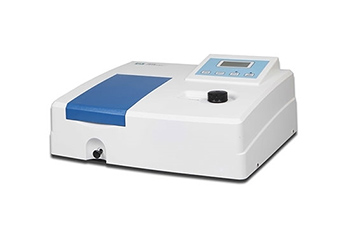How Does a Spectrophotometer Work?
A spectrophotometer is a scientific instrument that decomposes light with complex components into spectral lines. The measurement range generally includes the visible light region with wavelengths ranging from 380nm to 780 nm and the ultraviolet region with wavelengths ranging from 200nm to 380 nm. Different light sources have their own unique emission spectrum, so different luminous bodies can be used as the light source of the instrument.
Today, let's study the composition, working principle, and characteristics of a spectrophotometer. We hope that after reading this article, you will have a general idea of spectrophotometers.
Basic principle
The absorption spectrum of substances is measured using ultraviolet light, visible light, infrared light, and laser light. The method of qualitative and quantitative analysis and material structure analysis of substances using this absorption spectrum is called spectrophotometry. This spectrophotometer has high sensitivity, fast measurement speed and wide application range. Among them, UV/Vis spectrophotometry is one of the essential basic methods in biochemical research.
Spectrum: Light is an electromagnetic wave and can be represented by the wavelength "λ". The electromagnetic spectrum consists of a spectrum of continuous wavelengths of different properties. For biochemistry, the most important wavelength regions are visible and ultraviolet light.
The wavelength of light is the distance between two adjacent wave crests.
The propagation of light is constituted by the mutually perpendicular electric field component "E" and magnetic field component "H".
λ=C/ν (λrepresents wavelength. C represents speed of light. V represents frequency )
The number of waves passing through a fixed point per unit time.
The ultraviolet region can be divided into ultraviolet (near ultraviolet) and vacuum ultraviolet (far ultraviolet). Since absorption cells (also known as sample cells, cuvettes, etc.) and optical components and oxygen can absorb light with a wavelength of less than 190 nm, conventional UV measurements are concentrated in the near-ultraviolet region, that is, 200 nm to 400 nm. The visible light region is 400nm to 800nm.
The molecules that make up a substance are in a certain state and are constantly moving. Molecular motion can be divided into translation, rotation, vibration and the movement of electrons in the molecule. Each state of motion is at a certain energy level, so the energy of a molecule is the sum of all its energy levels.
Each energy of a molecule has a series of energy levels. The energy level is not arbitrary, but has quantized characteristics. Usually, the molecule is in the ground state. When it absorbs a certain energy and transitions to the excited state, an absorption spectrum is generated.
Molecular rotations, vibrations, and transitions of electronic energy levels, correspondingly produce rotational, vibrational, and electronic spectra.
According to the principle of quantum mechanics, the energy state of molecules changes in a jumping manner according to certain rules. Under the irradiation of incident light, when the molecules absorb light, the increase of its energy is discontinuous. The frequency of, and the energy difference between the two energy levels must conform to the following relationship:
E=E2- E1=h
E1 and E2 represent the energy of the initial energy state and the final energy state respectively. The larger the energy difference between the initial energy state and the final energy state, the higher the frequency of the absorbed light (that is, the shorter the wavelength). The lower the frequency of the light (like the longer the wavelength).
Since the absorption is discontinuous, a series of absorption dark bands appear at certain parts of the light. As the energies of molecular rotation, vibration and electron energy level transition are quite different, and their absorption spectra appear in different spectral regions. The molecular rotation energy level difference is small, △E<0.05 electron volts (ev), and the absorption of molecular rotation spectrum appears in the far infrared or microwave region.
The vertical difference between the vibrational energy levels is large, E=0.05~1.0 ev, and the vibrational spectrum appears in the mid-infrared region. The difference of electron energy level is larger, E=1~20ev, so the spectrum obtained by electron transition appears in the visible, ultraviolet or shorter wavelength spectral region.
Calculating principle
The spectrophotometer uses a light source that can generate multiple wavelengths. And through a series of spectroscopic devices, there is a light source of a specific wavelength. After the light passes through the sample under test, part of the light is absorbed. Calculate the absorbance of the sample to convert to the concentration of the sample. The absorbance of the sample is proportional to the concentration of the sample.
When the monochromatic light radiation passes through the solution of the substance to be tested, the amount absorbed by the substance is proportional to the concentration of the substance and the thickness of the liquid layer (optical path length). And the relationship is as follows:
A=-lg(I/ I0)=-lgT=kLc
In the formula: A is the absorbance.
I0 is the incident monochromatic light intensity.
I is the transmitted monochromatic light intensity.
T is the transmittance of the substance.
K is the molar absorption coefficient.
L is the optical path of the substance to be analyzed, that is, the side length of the cuvette.
C is the concentration of the substance.
The selective absorption wavelength of light by a substance, and the corresponding absorption coefficient are the physical constants of the substance. When the absorption coefficient of a pure substance under certain conditions is known, the test sample can be prepared into a solution under the same conditions, and its absorbance is measured, and the content of the substance in the test sample can be calculated from the above formula.
In the visible light region, in addition to some substances that absorb light, many substances do not absorb light themselves, but can be determined by adding color reagents or processing to develop color under certain conditions. Therefore, it is also called colorimetric analysis.
Since there are many factors that affect the color depth during color development, and instruments with poor monochromatic light purity are often used, standard substances or reference substances should be used for simultaneous operation.

